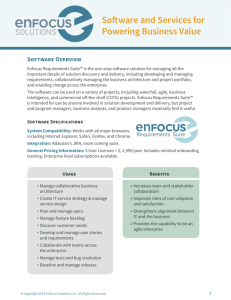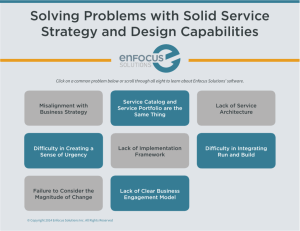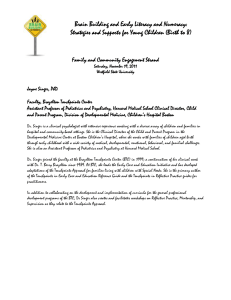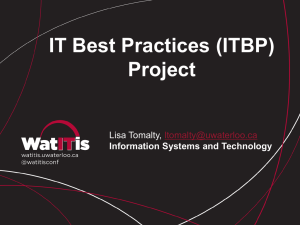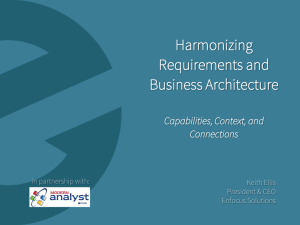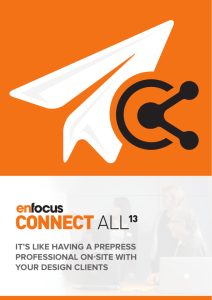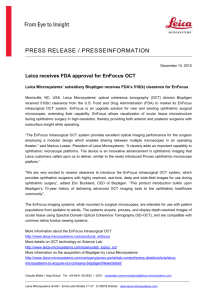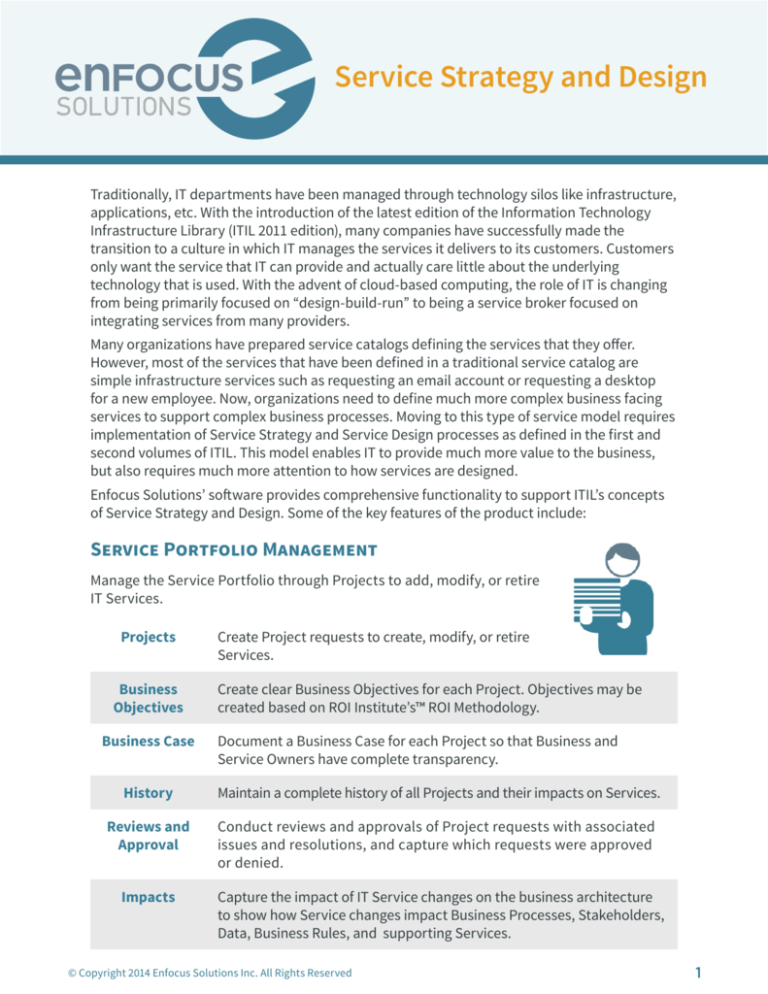
Service Strategy and Design
Traditionally, IT departments have been managed through technology silos like infrastructure,
applications, etc. With the introduction of the latest edition of the Information Technology
Infrastructure Library (ITIL 2011 edition), many companies have successfully made the
transition to a culture in which IT manages the services it delivers to its customers. Customers
only want the service that IT can provide and actually care little about the underlying
technology that is used. With the advent of cloud-based computing, the role of IT is changing
from being primarily focused on “design-build-run” to being a service broker focused on
integrating services from many providers.
Many organizations have prepared service catalogs defining the services that they offer.
However, most of the services that have been defined in a traditional service catalog are
simple infrastructure services such as requesting an email account or requesting a desktop
for a new employee. Now, organizations need to define much more complex business facing
services to support complex business processes. Moving to this type of service model requires
implementation of Service Strategy and Service Design processes as defined in the first and
second volumes of ITIL. This model enables IT to provide much more value to the business,
but also requires much more attention to how services are designed.
Enfocus Solutions’ software provides comprehensive functionality to support ITIL’s concepts
of Service Strategy and Design. Some of the key features of the product include:
Service Portfolio Management
Manage the Service Portfolio through Projects to add, modify, or retire
IT Services.
Projects
Business
Objectives
Business Case
Create Project requests to create, modify, or retire
Services.
Create clear Business Objectives for each Project. Objectives may be
created based on ROI Institute’s™ ROI Methodology.
Document a Business Case for each Project so that Business and
Service Owners have complete transparency.
History
Maintain a complete history of all Projects and their impacts on Services.
Reviews and
Approval
Conduct reviews and approvals of Project requests with associated
issues and resolutions, and capture which requests were approved
or denied.
Impacts
Capture the impact of IT Service changes on the business architecture
to show how Service changes impact Business Processes, Stakeholders,
Data, Business Rules, and supporting Services.
© Copyright 2014 Enfocus Solutions Inc. All Rights Reserved
1
Service Strategy and Design
www.EnfocusSolutions.com
Collaborative Business Architecture
Maintain a business architecture in a collaborative, distributive manner.
For example, Service Owners can maintain information about their Service,
Process Owners maintain information about their Processes, and data
management groups maintain information about enterprise Data.
Services
Organize Services into Service Groups and manage a Portfolio of
the Services. Create separate Service Groups for Technical and
Business Services.
Business
Processes
Link Services to Business Processes. Also, maintain comprehensive
information on Business Processes, including activities, RACIs, and
continual process improvement data.
Enterprise
Data
Capture information on enterprise master Data. Optionally capture
how Service Components create, modify, or delete Data using
CRUD matrices.
Stakeholder
Personas
Create Stakeholder Personas for customers and users, and map the
Personas to IT Services.
Business
Rules
Create Rule Books to maintain information about Business Rules. Rule
Books provide an excellent mechanism for service governance.
Record
Owners
Each architectural record has a record owner who has complete
security rights over the architectural component. Record owners are
notified if another architectural item (e.g., a Business Process, Business
Rule, etc.) or Project impacts their record (e.g., service).
Service Design
Create Service definitions and prepare Service Design Packages using
the features described below.
Service
Design
Coordination
Provide automated support for the Service Design
Coordination Process as defined in ITIL.
Service
Governance
Track who serves as the Service Owner, Service Manager, and Service
Level Manager.
Service
Definitions
Define IT Services in a consistent manner and maintain in
Service Portfolio.
© Copyright 2014 Enfocus Solutions Inc. All Rights Reserved
2
Service Strategy and Design
www.EnfocusSolutions.com
SLA, OLA,
and UC
Attach Service Level Agreements (SLAs), Operating Level Agreements
(OLAs, and Underpinning Contracts (UCs) to Services.
Service
Design
Package
Maintain comprehensive Service Design Packages as defined in ITIL.
Service
Groups
Organize Services into Service Groups for easy access and administration.
Service
Features
Review complete list of Service Features organized by the Project or
imitative that created them.
Service
Components
Customer
Personas
Customer
Touchpoints
Providers and
Suppliers
Define the Components that make up a IT Service and support
reusability of Components between Services.
Document information about customers that buy or consume the Service.
Document Touchpoints of how customers interact with the Service.
Designate Touchpoints as Service requests to document all Service
requests and organize according to IT Service. Touchpoints can also
be used to document buyer touchpoints to identify things such as
payments, invoices, credits, etc.
Services have providers and suppliers. Providers represent the
organization, either internal or external, that directly provide the
Service to the customer. Suppliers provide support Services and/ or
products to the provider organization that underpin the Service being
provided. Create Stakeholder Personas for providers and suppliers to
track which Services are provided by each supplier or provider.
Manage all information about an IT Service, including related business architecture such as
supporting Business Processes.
© Copyright 2014 Enfocus Solutions Inc. All Rights Reserved
3
Service Strategy and Design
www.EnfocusSolutions.com
Service
Delivery
Information
Capture availability and capacity design information for each Service.
Related
Services
Document which Technical Services are needed to provide the
Business Service.
Related
Data Entities
(CRUD)
Track how Service Components update and create Data using a
CRUD matrix.
Business
Process
Show which Business Processes are supported by the Service
and which Business Processes are needed to provide and support
the Service.
Requirements Management
Define and manage Requirements using the capabilities explained below.
Project
Management
Features
Link development Projects to Services.
Decompose the Project into a set of Features that can be designed and
delivered independently.
Agile and Plan
Driven
Support both agile and plan-driven development lifecycles.
Inspect and
Adapt
Verify and validate deliverables using Lifecycle Events and
Verification templates.
Electronic
Approvals
Conduct reviews and approvals electronically, cutting days off
cycle times.
Scenarios
Have users describe workflow and activities using Scenarios.
Use Cases
Describe how an IT Service will be used with Use Cases.
Requirements
Document Functional and Non-Functional Requirements.
Transition
Requirements
Use Transition Requirements to document user training needs and
Data Conversion Requirements.
Service Level
Requirements
Document Service Level Requirements using Non-Functional
Requirements (NFRs).
Requirement
Bundles
Distribute Requirements to service suppliers electronically using
Requirement Bundles.
© Copyright 2014 Enfocus Solutions Inc. All Rights Reserved
4
Service Strategy and Design
www.EnfocusSolutions.com
Test Scenarios
and Test Cases
Define Test Scenarios and Test Cases and link to Requirements.
Fit/Gap
Analysis
Use the Requirements to see how well a purchased or cloud-based
Service meets the Requirements.
Baseline
Requirements
Baseline a Requirement Bundle to prevent further modifications
or changes.
Change
Requests
Manage changes to Baselined Bundles with Change Requests.
Requirements
Traceability
Trace Requirements both forward and backward from the point they
were identified through the point they were deployed and included
with the service offering.
About Enfocus Solutions
We are an IT professional services and software company servicing organizations as effective
agents of change. Our tailored solutions provide everything required to achieve your business
goals, including software, training, coaching, and other services. We are passionate about
helping our clients make positive changes in their businesses—changes that improve value
delivery to customers and bring positive benefits to the bottom line.
Contact Us To Discuss Working Together
Phone:
(210) 399-4240
Toll-free:
(877) 253-0275
Email:
info@EnfocusSolutions.com
© Copyright 2014 Enfocus Solutions Inc. All Rights Reserved
5

